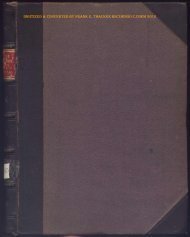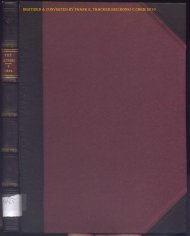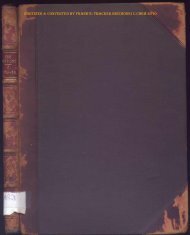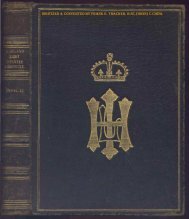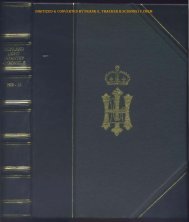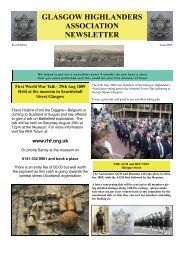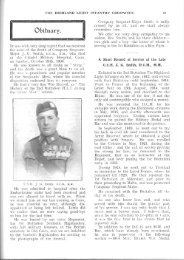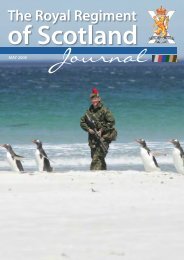Journal 2008 - The Journal Royal Highland Fusiliers - The Royal ...
Journal 2008 - The Journal Royal Highland Fusiliers - The Royal ...
Journal 2008 - The Journal Royal Highland Fusiliers - The Royal ...
You also want an ePaper? Increase the reach of your titles
YUMPU automatically turns print PDFs into web optimized ePapers that Google loves.
have a truly devastating effect.) My Company Commander,Major Andrew Agnew, a direct descendant, was the firstOfficer of the 6th Battalion <strong>Royal</strong> Scots <strong>Fusiliers</strong> to be killedin our first engagement on 26th June 1944. This was with thefanatical 12th SS (Hitler Youth Division) at Saint Manvieuat the start of “Operation Epsom”, which culminated in thecapture of “<strong>The</strong> Scottish Corridor” (a six-mile salient into sixSS divisions) and the capture of two bridges over the RiverOdon by the Argyll and Sutherland <strong>Highland</strong>ers. Andrewwas very popular and a great loss. This action resulted in theholding up of the six SS divisions and preventing them fromgetting to General Roosevelt and the Americans who wereadvancing from Utah Beach.It was now raining so a planned picnic had to be moved intothe nearby village hall. Here we were fortunate, as Count Jeanis the Maire! A very happy lunch with plenty of good wine wasfollowed by a pre-arranged visit to St Mere Eglise Museum andthen our return to Bayeux. That evening we were supposed toattend a special event at Longues-sur-Mer, but the traffic jamwas unbelievable and the car parks looked very full, even from adistance. Instead we went on to Port-en-Bessin, at the Western endof Gold Beach, a fishing port captured by <strong>Royal</strong> Marines, where weenjoyed a special drink on Tony Watts in a dockside bar.On “D” Day 6th June our main party attended the Anglo-Frenchofficial military ceremony by the Norman Fortress at Caen,where the smartness and bearing of British Regulars was a sightfor sore eyes.I went instead as one of our representatives to Bayeux Cathedral,a most magnificent building, to attend a British Legion Service ofRemembrance, with the Band of the Parachute Regiment makingthe most of the perfect acoustics. Arranged by the NormandyBranch of the Legion, it was a very moving Service, attended bythe British Ambassador Sir Peter Wheatcroft, top Brass from theParis Embassy and a Brigadier from 3rd Division. Another verywelcome guest was the Head of the Commonwealth War GravesCommission. I was glad of the opportunity to thank him for thewonderful and dedicated gardeners who tend the British WarCemeteries so perfectly. I have met the Frenchman who looksafter 1600 British and 500 German graves without any help. <strong>The</strong>lawns and hedges are immaculate, and at this time of year a roseblooms on every grave, so comforting to many visiting relativesand old comrades at St Manvieu, many from our 15th (Scottish)Division. I was accompanied by an ATS veteran, Merville Ridgeon(in Bayeux in 1944), and the former Mayor and Mayoress of Poole,Les and Mary Rose Burden.We then went across to the Hotel de Ville (Town Hall) where wewere welcomed by the Mayor of Bayeux. We were to receive a“Vin d’Honneur” and did – but I must say that I wish we couldhave had a drink before the rather protracted speeches, eloquentas they were. After rejoining our main party for lunch we visitedthe British Commonwealth Cemetery in Bayeux for more wreathlaying and more memories before travelling to Caen for a visit tothe vast Memorial Museum. Very impressive but in the long filmthere is still no mention of the tremendous part our 15th (Scottish)Division played in the Battle of Normandy. <strong>The</strong> Division engagedthe six SS Divisions opposed to us in the “Bocage” for 3 days,thereby giving General Roosevelt at Utah Beach a chance toestablish the American bridgehead there.On Thursday 7th June we attended the Liberation of BayeuxAnglo-French Ceremony outside the Battle of NormandyMuseum. <strong>The</strong> Liberation had been 63 years before and, achievedby the Sherwood Rangers and the Essex Regiment, was the firstBritish triumph in capturing a major city. <strong>The</strong> ceremony was verymoving and was beautifully conducted by a British Padre withappropriate music and ceremonial.<strong>The</strong> journey home started with a pleasant lunch at St Marie duMont. We were joined by the Mayor of the Town and his wife, butCount Jean was detained by a modern US General and could onlyarrive after lunch.<strong>The</strong> visit ended with a good crossing and pleasant dinner to Pooleand home.On the 24th June, my old comrade Piper Les Womack and Ireturned to Normandy on the fast ferry. It poured with rain all day,but I was very pleased that Count Jean managed to join us at StMarie du Mont, bringing further proof of his Scottish connections,a book recording the exploits of many members of the Agnewfamily. He was also very near to our battleground in 1944 as asmall boy and has vivid recollections of the German occupation.We stayed at the comfortable Hotel Argouge in Bayeux andalso returned to an excellent restaurant, where I receive a greatwelcome every year. <strong>The</strong> taxi driver refused to accept our returnfare to our hotel, a nice gesture from a young Frenchman.On Monday we went back to the Canadian Museum atCourseulles, which is my favourite, and Les played a goodselection of pipe tunes outside the Museum. <strong>The</strong>se were wellreceived by staff and visitors.After lunch we motored to our 15th (Scottish) Division Memorialat Tourville, over looking the two bridges over the River Odoncaptured by the Argylls in 1944. It is the most impressivememorial I have seen and carries a “Lion Rampant” at the top, ourDivisional Sign. It also bears the title of every unit in the Division,including Supporting Arms.We decided to cross the Odon over the bridge which was veryclose to the cottage where our Brigadier decided to make his HQ.(His reasons for this were not entirely military; the cottager hadJerusalem artichokes in his garden. A costly exercise it proved as wewere mortared by Nebelwerfers (“Moaning Minnies”) and suffereda number of wounded, before we were withdrawn to a “fortified”farm house, still in shelling range of the Germans.)Les and I drove on to Baron-sur-Odon, a village liberated by6 RSF in 1944. Calling at the Mairie to pay our respects, wewere surrounded by children from the adjoining school, about100 in all. Les played pipe tunes to which the children dancedand clapped and sang their sole English repertoire, “London’sburning”! <strong>The</strong>y did not want us to leave, reminding me of thePied Piper!On Tuesday the 26th (the date of our first engagement with theHitler Youth in 1944), we met Ted Thurston, a sniper with 10HLI, later <strong>Royal</strong> Military Police, and now Chairman of the NVABranch 70, at St Manvieu cemetery where lie 1600 British and 500German dead.THE ROYAL HIGHLAND FUSILIERS 65



